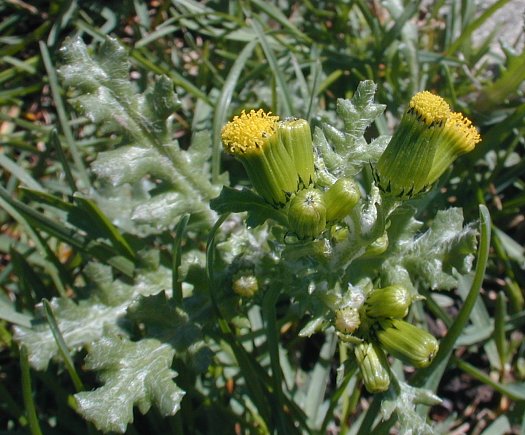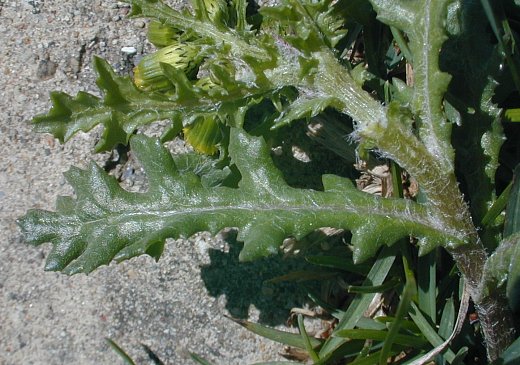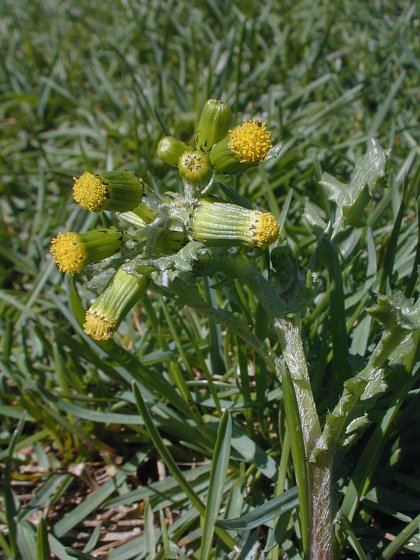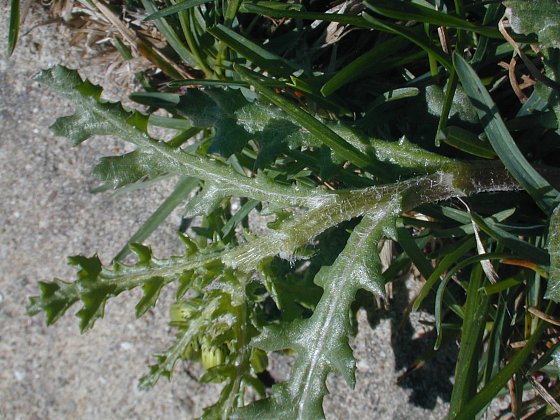Description: This plant is a winter, spring, or summer annual that becomes 3-10" tall at maturity, branching occasionally. The terete stems often have fine longitudinal veins that are visible on the outside, while on the inside they are hollow. Toward the base of the plant, these stems are often purplish green, becoming green above. The alternate leaves are up to 4" long and ¾" across. They are usually pinnatifid with a few blunt teeth along their margins in addition to the lobes. The terminal and lateral lobes are often truncated or notched, rather than tapered and pointed. The edges of the leaf margins curve downward (revolute). The lower leaves have short stout petioles, while the upper leaves are sessile or they clasp the stems. Some of the uppermost leaves may be lanceolate to oblong and smaller in size. Both the stems and leaves are slightly succulent and fleshy. The hairiness of the stems and leaves is variable, ranging from hairless to moderately covered with white hairs that are appressed and cobwebby in appearance.

The upper stems terminate in small dense clusters of flowerheads on very short peduncles. Individual flowerheads are more or less cylindrical in shape, tapering slightly above; they are about 1/3" (8 mm.) in length and about 1/6" (4 mm.) across. The apex of each flowerhead is densely crowded with tiny disk florets; there are no conspicuous petaloid rays. Each disk floret has a narrowly tubular corolla with 5 slender lobes; the visible apex of the corolla is yellow. The inner floral bracts (phyllaries) are arranged in a single appressed series around the base of each flowerhead; they are green, hairless, and linear in shape, sometimes with black upper tips. There are also outer floral bracts that are shorter and spread slightly outward from the base of the flowerhead. These latter bracts are green, hairless, linear-lanceolate in shape, and their upper tips are sometimes black. The blooming period for a colony of plants can occur from early spring to late fall, although blooming plants are mostly likely to be encountered during the cool weather of spring or fall. Individual plants remain in bloom for about 2-4 weeks. Afterwards, the disk florets are replaced by slender achenes that are finely short-pubescent; they have small tufts of white hair at their apices, enabling them to be distributed by the wind. In addition, the achenes can become sticky when they are wet. The root system consists of a shallow taproot. This plant reproduces by reseeding itself.

Cultivation:
Common
Groundsel is often found in full or partial sun, mesic conditions, and
fertile loamy soil. This plant blooms in as little as 5 weeks after the
seeds
germinate, and it favors cooler weather during the spring or
fall. Several generations of plants can be produced during a single
year.
Range & Habitat:
In many areas where it occurs, Common Groundsel is often locally
common,
otherwise it is uncommon or absent. In Illinois, Common Groundsel
occurs primarily in NE Illinois and a few counties in central Illinois
(see Distribution
Map). Because this plant is rather inconspicuous, it is
possible that official records underestimate its actual distribution
within the state. Habitats include lawns, gardens, edges of yards,
nursery plots, mulched beds around shrubs, areas along railroads,
roadsides, fields, and waste areas. This plant
prefers highly disturbed areas where the ground vegetation is low and
scant. Common Groundsel is native to Eurasia.

Faunal
Associations:
The tiny florets occasionally attract flower flies and small bees.
Insects that feed on this plant include the leaf beetle Longitarsus jacobaeae,
the polyphagous aphid Macrosiphum
gei, and caterpillars of the moth Orthonama
obstipata (The Gem). This plant is not a significant source
of food for mammalian herbivores because the foliage contain a toxic
alkaloid that can damage the liver, although goats and sheep are more
resistant. The value to
wildlife of this species is rather low.
Photographic Location:
At the edge of a lawn near the web master's apartment complex in
Urbana,
Illinois.

Comments: This is an inconspicuous little plant that is easily overlooked. There is another introduced species with a similar appearance. This species is Sticky Groundsel (Senecio viscosus), which has foul-smelling foliage that is covered with sticky glandular hairs. Unlike Common Groundsel, the floral bracts (phyllaries) of Sticky Groundsel are spreading-hairy, rather than glabrous. While Common Groundsel sometimes has hairs on its stems and leaves, like Sticky Groundsel, they are non-glandular and its foliage isn't foul-smelling. Some authorities assert that the foliage of Common Groundsel is always without hairs and its phyllaries never have black tips, but this isn't true. Usually the flowerheads of Sticky Groundsel also have conspicuous petaloid rays (1-10 mm. in length) along their outer margins that are yellow. In contrast, Common Groundsel never has conspicuous petaloid rays.